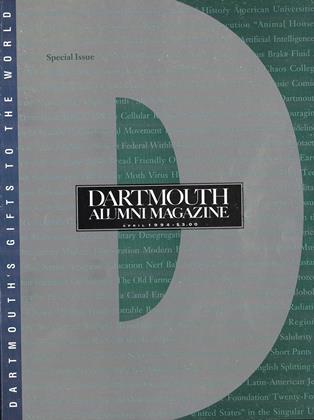Only Webster can compare with Salmon P. Chase 1826 as Dartmouth's most brilliant statesman and political insider. Chase began his legal career as a defender of fugitive slaves (and an advocate for women's suffrage), became a U.S. Senator, Ohio governor, Lincoln's secretary of the treasury, and the sixth Chief Justice of the Supreme Court.
It was in Lincoln's Cabinet that Chase earned a future spot on the $10,000 bill. The architect of a strong federal banking system, he devised the means for the Union to fund the Civil War. Under Chase's system, nationally chartered banks were required to back their notes with government securities. Not since the days of Andrew Jackson had anyone attempted such a direct government role in the nation's money supply.
His stint in the Cabinet was not a complete triumph, however. Having made his own unsuccessful bid for the White House only to be defeated for the Republican nomination by Abraham Lincoln Chase accepted the Treasury post in hope of becoming the "First Friend." It was not to be. Lincoln (not without justice) thought the stern-browed Yankee lacked a sense of humor.
Stefansson brought his Inuitcolleagues to campus.
Chase tries to capture thRepublican Presidentialnomination in this cartocby Thomas Nast.
 View Full Issue
View Full Issue
More From This Issue
-
 Cover Story
Cover StoryROSTER OF DARTMOUTH'S GIFTS TO THE WORLD
April 1994 -
 Article
ArticleThe Greatest Books by Dartmouth Authors
April 1994 -
 Class Notes
Class Notes1993
April 1994 By Christopher K. Onken, -
 Class Notes
Class Notes1981
April 1994 By Karen McKeel Calby, -
 Class Notes
Class Notes1989
April 1994 By Dan Parish, -
 Class Notes
Class Notes1983
April 1994 By Deborah Michel Rosch.
Article
-
 Article
ArticleCAMPUS NOTES
February 1919 -
 Article
ArticleFormer President Ernest Fox Nichols has recently given up his professorship
May 1920 -
 Article
ArticleD. C. A. ESTABLISHES ROOM REGISTRY
April, 1922 -
 Article
ArticleMEMBERS OF OLD DARTMOUTH FAMILIES .RECENTLY BURIED IN HANOVER
May 1925 -
 Article
ArticleOVER-EMPHASIS
January, 1931 -
 Article
ArticleThe Faculty
DECEMBER 1965 By GEORGE O'CONNELL


